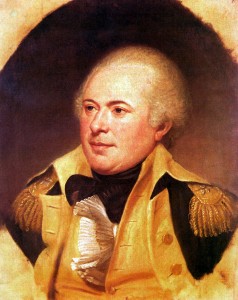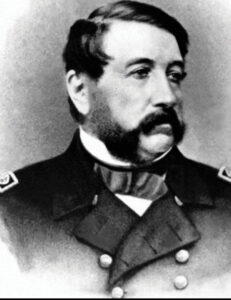Written By: LTC Roger D. Cunningham, USA-Ret.

Army Art Collection)
In order to fight the War with Mexico, the United States had to greatly expand the strength of its small Regular Army. In February 1847, Congress authorized the organization of nine additional infantry regiments, one of which was designated as the Regiment of Voltiguers and Foot Riflemen. During the Napoleonic Wars, voltiguer companies had served as “skirmishers” within French light infantry regiments, and they were generally considered to be elite units. Believing that such a unit would be useful in the campaigns in Mexico, the War Department originally planned that half of the regiment would be mounted, half would be on foot; the latter half could be mounted behind the horsemen to facilitate quick tactical movements.
Throughout the war, however, the Voltiguers remained a unit of foot riflemen, armed with the model 1841 .54-cal. “Mississippi Rifle.” A company of mountain howitzers and rockets was also included with the regiment, although it was not tactically linked to the riflemen. This caused one newspaper to erroneously report that the Voltiguers “form a little army of themselves, of dragoons, infantry and artillery.”
Authorized forty-seven officers and 1,104 men, the ten companies of Voltiguers were primarily recruited from six states—Georgia, Kentucky, Maryland, Mississippi, Pennsylvania, and Virginia. The regiment seemed to have no problem attracting adequate recruits, thanks in part to advertisements such as the one that appeared in Georgia’s Savannah Republican. The ad reported that “the nature of the service makes a situation in this regiment one of the most desirable in the Army. The soldier will receive, in addition to his regular pay, a sufficiency of comfortable and genteel clothing, good quarters and fuel, and ample subsistence.”

An Army paymaster, MAJ Timothy P. Andrews, was promoted to colonel and given command the regiment. Andrews had immigrated to this country from Ireland and had twenty-five years of service in the Pay Department. The regiment’s lieutenant colonel billet was given to CPT Joseph E. Johnston, an 1829 graduate of the United States Military Academy, who was serving in the Corps of Topographical Engineers. Johnston was in Mexico, assigned to the staff of MG Winfield Scott, as the Voltiguers were being organized, and he was wounded at the Battle of Cerro Gordo in April.

He did not join the regiment until after its companies began to arrive in Mexico. The initial regimental adjutant was 1LT William S. Walker, a Pennsylvanian who had been raised by his uncle, Senator Robert J. Walker, of Mississippi. Senator Walker was then serving as President James K. Polk’s secretary of the treasury and perhaps used his influence to secure his nephew a commission in the Voltiguers.
General orders mandated a unique uniform of dark gray cloth for the Voltiguers, but the enlisted men wore standard infantry blue uniforms throughout their service. The dark gray cloth was manufactured and delivered to the Philadelphia Clothing Depot, but it had not been cut into uniforms as late as January 1848. That same month, COL Andrews informed the adjutant general that “officers equipped themselves in this country with the grey cloth, but none of that cloth being for sale in Mexico, those who had to renew their uniforms have done so with the blue color.”
The Voltiguers did, however, have a unique button, which featured a raised letter “V” in a recessed shield in the center of a right-facing eagle. As they were organized, the Voltiguer companies departed from different American ports, including New Orleans and Savannah, and sailed across the Gulf of Mexico to the port of Veracruz, which had surrendered to MG Winfield Scott after a short siege in March 1847. After Scott left the Mexican coast and marched inland toward Mexico City, the first Voltiguers to see action—Company B—fought in an engagement at National Bridge, on 11-12 June.
After the companies were able to assemble in Puebla, where Scott halted for three months to bolster his strength, the complete regiment participated in the major battles that were fought around Mexico City during the summer—Contreras, Churubusco, Molino del Rey, and Chapultepec.
The regiment particularly distinguished itself by conducting two battalion-sized attacks during the bloody 13 September battle at Chapultepec Castle. The Army had no decorations to recognize battlefield heroism in 1847, but eight Voltiguer privates were awarded the Certificate of Merit—later equated to the Distinguished Service Cross—for their distinguished services at Chapultepec, while at least a dozen of their officers received brevet promotions, including COL Andrews, LTC Johnston, MAJ George A. Caldwell, five captains, and four lieutenants. The regiment’s other major, George H. Talcott, an 1831 West Point graduate, had already earned a brevet promotion at the Battle of Molino del Rey.
Mexico City surrendered the day after the Battle of Chapultepec, but Scott’s Army continued to deal with guerrilla activities. One company of Voltiguers engaged in fighting at Atlixco on 19 October before the regiment settled into performing peaceful occupation duties. The regiment returned to the United States after the Treaty of Guadalupe Hidalgo ended the war in February 1848. It was disbanded at Fort McHenry, Maryland, in August, and its veterans either re-enlisted in the Army or returned to their civilian occupations. Several of the Voltiguer officers later achieved distinction during the Civil War.

Andrews returned to the Army’s Pay Department and served as the paymaster general from 1862 until he retired in 1864. CPT James J. Archer, a company commander, was a Confederate brigadier general when he died in 1864. 1LT Birkett D. Fry, the regiment’s second adjutant, moved to California as a “Forty-niner” and accompanied William Walker on his infamous filibustering expedition to Nicaragua in 1856, before also serving as a Confederate brigadier general.
As a brigade commander, he participated in Pickett’s Charge at the Battle of Gettysburg, where he was wounded, captured and later exchanged. 1LT James E. Slaughter, a great-nephew of President James Madison, also served as a Confederate one-star. 1LT Walker, the regiment’s first adjutant, remained in the Army as a cavalry officer but resigned his commission in 1861 and eventually served as a Confederate brigadier general as well. Joseph E. Johnston, of course, became one of the Confederacy’s four-star generals and commanded both the Army of Northern Virginia and the Army of Tennessee. Other Voltiguer officers, and probably many more of the regiment’s enlisted men, also fought for either the North or the South.
The Regiment of Voltiguers and Foot Riflemen served the nation well during its relatively brief eighteen months of military service. Sadly, the regiment is largely forgotten today, in large measure because no current Army units have inherited its lineage and honors. Surprisingly, Voltiguer buttons are sometimes found by relic hunters at Civil War campsites associated with Virginia troops, perhaps because militia companies from the Old Dominion also found them appropriate for their uniforms.



